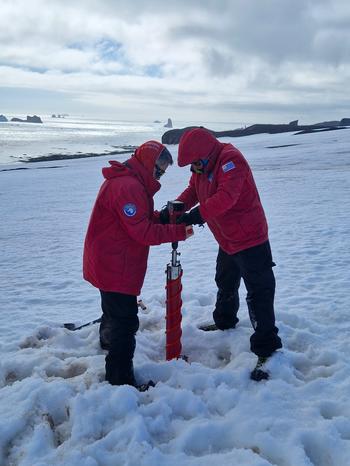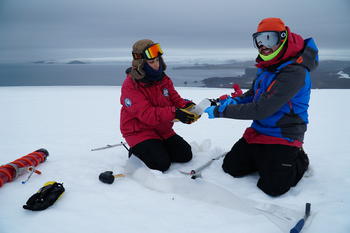First fieldwork campaign for the Icy Moons group: Antarctica
Collection of ice cores on the glacier. Credits: Pablo L. Finkel.
Lucía Hortal and Pablo L. Finkel collecting samples on Collins glacier. Credits: Maryse Napoleoni.
News from Apr 10, 2024
The start of 2024 marked new beginnings for the Icy Moons group in the Planetary Sciences and Remote Sensing department at Freie Universität Berlin: the group carried out their first ever fieldwork campaign!
This new adventure brought two of its members, Dr. Maryse Napoleoni (PostDoc researcher) and Lucía Hortal (PhD student), to one of the most remote places on Earth, Antarctica.
The aim of this astrobiology research project is to study terrestrial analogues to the icy moons Enceladus and Europa, satellites of Saturn and Jupiter respectively. It was developed in collaboration with the Centre of Astrobiology (CAB), in Spain, where Pablo L. Finkel and Laura Sánchez, the two other members of this fieldwork campaign, also carry out research in astrobiology.
As part of the summer Antarctic campaign of the Instituto Antártico Uruguayo (IAU), the team sampled ice from Collins glacier, located in King George Island (South Shetland Islands, Antarctica). Antarctic glaciers, such as this, are considered good analogues to the surfaces of icy moons in the solar system, which are objects of study for upcoming space missions.
In the ice samples collected, Maryse and Lucía expect to find organic material relevant for their astrobiological studies and they will characterize it using the Laser-Induced Liquid Beam Ion Desorption (LILBID) mass spectrometer, an experimental set-up located in the Planetary Sciences’ laboratory. This set-up has already proven its reliability in calibrating spaceborne mass spectrometers on board space missions, such as the Cosmic Dust Analyzer (CDA) on board Cassini.
The data resulting from the present campaign will serve, in a similar manner, to calibrate CDA’s successor instrument, the SUrface Dust Analyzer (SUDA). This new-generation spaceborne mass spectrometer will fly on board the upcoming NASA mission “Europa Clipper”, expected to launch October 2024, and will help characterize the Jovian moon’s habitability.
This Antarctic campaign was funded by Dr. Nozair Khawaja through the FUB grant “START” and the Department of Molecular Evolution at CAB. It was carried out in collaboration with the IAU, who hosted the team in its Antarctic scientific research station “Artigas”.

